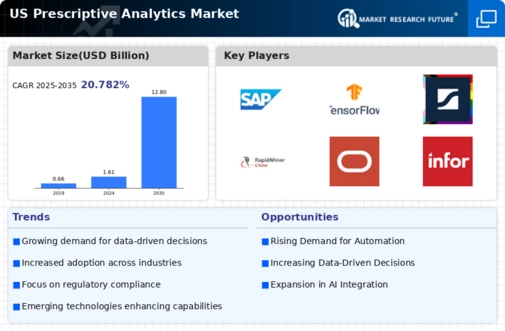The US Prescriptive Analytics Market is rapidly evolving, characterized by a diverse landscape of key players and innovative solutions aimed at optimizing decision-making processes across various industries. Companies operating in this market are leveraging advanced algorithms, big data, and machine learning techniques to generate insights that not only describe past performance but also prescribe actionable solutions for improved future outcomes. Competitive dynamics are shaped by factors such as technological advancements, the integration of artificial intelligence, and an increasing demand for data-driven decision-making tools.
The growing acceptance of prescriptive analytics among businesses looking to enhance operational efficiency and customer engagement is fostering a competitive environment in which established firms and startups are continuously refining their offerings to capture market share.In the realm of prescriptive analytics within the United States, SAP has cemented itself as a dominant player by providing a robust suite of analytical tools that help businesses optimize their operations. SAP's solutions are renowned for their ability to seamlessly integrate with existing enterprise systems, providing users with comprehensive insights into their operations.
With strong brand recognition and a deep understanding of various industry verticals, SAP offers a compelling value proposition to organizations aiming to harness the power of prescriptive analytics. The company’s commitment to R&D allows it to stay at the forefront of technological innovations, which, in turn, strengthens its competitive position in the US market. In addition, SAP’s customer-centric approach and diverse partnerships have cultivated a loyal customer base, further solidifying its influence in the prescriptive analytics space.
TensorFlow, while primarily recognized for its machine learning capabilities, plays a significant role in the US Prescriptive Analytics Market by offering an open-source framework that supports advanced analytics and predictive modeling. This platform enables organizations to develop custom analytical solutions tailored to their unique requirements, thereby enhancing their capacity to perform prescriptive analytics. TensorFlow’s adaptability and flexibility make it a choice framework for businesses looking to implement sophisticated analytics without being restricted to pre-packaged solutions. The presence of TensorFlow facilitates a collaborative ecosystem where data scientists and analysts can experiment and innovate within the analytics domain.
Furthermore, the ongoing development of TensorFlow, including its regular updates and incorporation of cutting-edge features, positions the platform as a vital player in the evolving field of prescriptive analytics. Its integration with various data-processing tools also enhances its utility within the US market, and despite not being a traditional analytics provider, TensorFlow’s impact is noticeably significant, contributing to numerous innovations and improvements in how companies approach decision-making processes.























